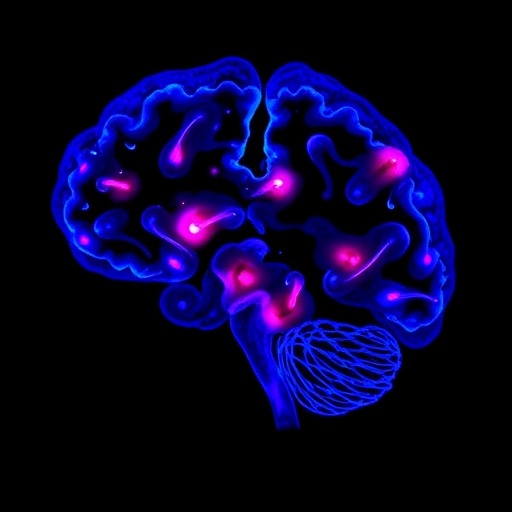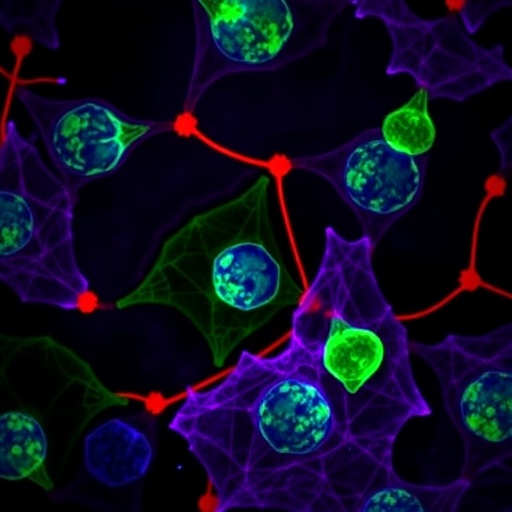In a groundbreaking new study published in Medical Oncology, researchers have unveiled a promising therapeutic avenue for glioblastoma, a notoriously aggressive and treatment-resistant brain cancer. The study focuses on how glioblastoma cells that survive initial chemotherapy with temozolomide (TMZ)—the current frontline alkylating agent—enter a senescent state that paradoxically makes them vulnerable to targeted apoptosis induction via the TRAIL (tumor necrosis factor-related apoptosis-inducing ligand) death receptor 5 (DR5). This dual-phase approach introduces a fresh strategy to circumvent the obstacles associated with treatment resistance and recurrence, potentially transforming glioblastoma therapy.
Glioblastoma multiforme (GBM) is one of the deadliest forms of brain cancer, characterized by rapid growth, invasiveness, and poor prognosis. Despite advances in surgery, radiotherapy, and chemotherapy, median survival remains grim, typically less than 15 months following diagnosis. Temozolomide has revolutionized induction therapy due to its ability to cross the blood-brain barrier and induce DNA alkylation, leading to tumor cell death. However, a significant fraction of glioblastoma cells manage to evade apoptosis by entering senescence—a durable growth-arrested state—which can contribute to tumor dormancy, relapse, and treatment failure.
Senescence, a cellular stress response characterized by permanent cell cycle arrest and metabolic changes, was previously thought to serve a primarily tumor-suppressive function. Nonetheless, emerging evidence highlights how senescent tumor cells might paradoxically maintain a pro-tumorigenic microenvironment by secreting inflammatory factors, collectively termed the senescence-associated secretory phenotype (SASP). Hence, eliminating these senescent tumor cells has become a priority in improving long-term treatment outcomes.
The latest research conducted by Isakova et al. explores the susceptibility of temozolomide-induced senescent glioblastoma cells to apoptosis through the activation of TRAIL death receptor 5. TRAIL selectively induces apoptosis in cancer cells by binding to its death receptors DR4 and DR5, sparing normal cells, which positions it as an attractive anticancer agent with minimal systemic toxicity. However, the variable expression of TRAIL receptors and intracellular resistance mechanisms has limited clinical success. This study’s novel insight that TMZ-induced senescent glioblastoma cells upregulate DR5 expression offers a new therapeutic window.
Using a suite of molecular biology techniques including flow cytometry, quantitative PCR, and immunoblotting, the researchers demonstrated that glioblastoma cells surviving temozolomide treatment undergo senescence accompanied by elevated cell surface expression of DR5. Intriguingly, this upregulation was consistently correlated with increased sensitivity to TRAIL-mediated apoptosis, underscoring a mechanistic linkage between the senescent phenotype and death receptor signaling pathways. These findings imply that senescent tumor cells, previously considered treatment-resistant, can be selectively targeted with TRAIL-based therapies to induce rapid cell death.
Further mechanistic investigations revealed that the senescent glioblastoma cells exhibit altered intrinsic apoptotic machinery, including the modulation of key pro- and anti-apoptotic proteins such as Bcl-2 family members. This reprogramming of apoptosis regulators primes the senescent cells for extrinsic pathway activation via death receptors. Importantly, cells that had not undergone senescence showed far less sensitivity to TRAIL, confirming the specificity of this vulnerability in the senescent state.
Building on this evidence, the researchers performed in vitro co-treatment experiments, initially exposing glioblastoma cultures to temozolomide to induce senescence, followed by administration of recombinant TRAIL ligand. The combination therapy resulted in robust apoptosis rates substantially exceeding those achieved by either agent alone. These results open the possibility of integrating sequential therapeutic regimens in clinical settings, where temozolomide primes tumor cells for subsequent eradication using TRAIL receptor agonists.
Another compelling aspect of the study lies in its translational promise. Current glioblastoma treatments often fail due to cellular heterogeneity and the emergence of chemoresistant subpopulations. By exploiting a vulnerability uniquely induced by standard chemotherapy, the proposed dual-modality approach offers a way to selectively eradicate senescent, dormant tumor cells that typically evade conventional therapies. Such ‘senolytic’ strategies, which aim to clear senescent cells, are gaining momentum in oncology research, and this study stands among the first to demonstrate their potential in aggressive brain tumors.
Moreover, the toxic side effects associated with many chemotherapy agents are a major clinical challenge. Since TRAIL preferentially targets cancer cells and spares normal tissues, combining it with temozolomide could enhance therapeutic efficacy without substantially increasing systemic toxicity. This therapeutic synergy may improve patient outcomes by reducing intratumoral residual disease and minimizing relapse probability.
From a molecular oncology perspective, the study underscores the critical role of death receptor dynamics and apoptotic reprogramming in cancer cell fate decisions. The upregulation of DR5 in senescent cells indicates an adaptive cellular response that, while protecting cells from proliferation, simultaneously exposes them to death receptor-mediated elimination. This paradox highlights the plasticity of tumor cells and the importance of timing and sequence in deploying targeted therapies.
Despite these promising findings, several challenges must be addressed before clinical translation. For instance, identifying biomarkers to stratify patients likely to benefit from such combination therapies will be key. Additionally, the pharmacokinetics, optimal dosing schedules, and potential immune-modulatory effects of TRAIL administration need thorough investigation. Future clinical trials will need to establish safety and efficacy in glioblastoma patients while exploring combinations with other immunotherapies or checkpoint inhibitors.
The study also invites broader questions about the role of senescence in cancer biology beyond glioblastoma. Senescence-induced sensitivities to various death receptor agonists may represent a universal vulnerability exploitable across other malignancies subjected to genotoxic therapies. Further research could uncover novel senolytic agents that, when combined with chemotherapy, provide potent and selective anticancer effects.
In summary, the compelling work by Isakova and colleagues marks a significant step forward in glioblastoma therapeutics by revealing that temozolomide-induced senescent tumor cells acquire sensitivity to TRAIL death receptor 5-mediated apoptosis. This discovery not only enhances understanding of tumor cell fate and resistance but also sets the stage for developing innovative, sequential combination therapies that could dramatically improve survival outcomes in one of the most lethal cancers. The integration of senescence biology and targeted apoptosis represents a frontier in cancer medicine poised for rapid clinical impact.
As research continues to dissect the molecular underpinnings of therapy-induced senescence and its exploitation, the vision of transforming deadly glioblastoma into a manageable or even curable disease draws closer. This study sheds critical light on the complex interplay between chemotherapy, cellular senescence, and apoptotic signaling, opening new therapeutic avenues in brain tumor treatment and potentially reshaping oncology paradigms in the coming decades.
Subject of Research: Glioblastoma treatment resistance mechanisms; therapeutic targeting of temozolomide-induced senescent glioblastoma cells
Article Title: Temozolomide-induced senescent glioblastoma cells acquire sensitivity to TRAIL death receptor 5-mediated apoptosis
Article References:
Isakova, A.A., Mazur, D.V., Antipova, N.V. et al. Temozolomide-induced senescent glioblastoma cells acquire sensitivity to TRAIL death receptor 5-mediated apoptosis. Med Oncol 43, 4 (2026). https://doi.org/10.1007/s12032-025-03130-4
Image Credits: AI Generated
DOI: https://doi.org/10.1007/s12032-025-03130-4
Tags: cellular senescence in cancerdual-phase glioblastoma treatment approachglioblastoma multiforme characteristicsglioblastoma recurrence challengesglioblastoma therapy advancementsinnovative treatments for aggressive brain tumorsovercoming treatment resistance in brain cancersenescent cell apoptosis sensitivitytargeted cancer treatment strategiestemozolomide chemotherapy resistancetherapeutic implications of senescenceTRAIL death receptor 5 mechanism





